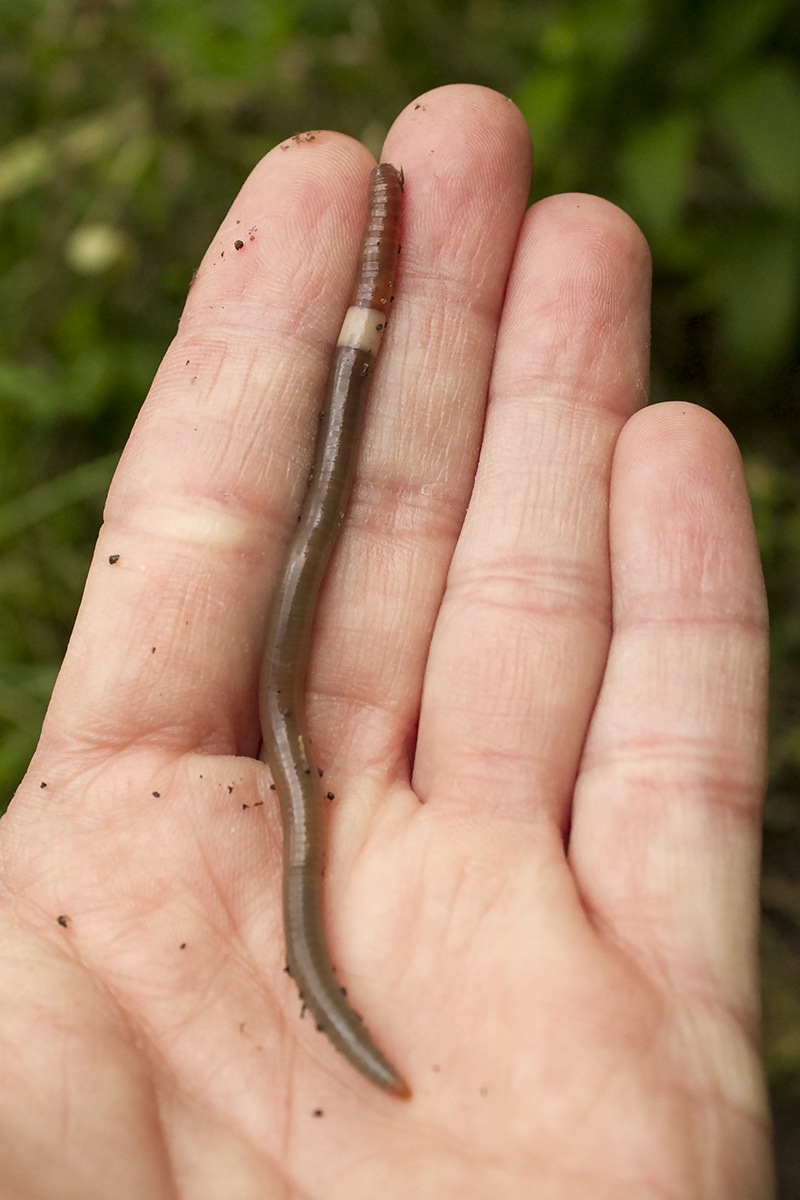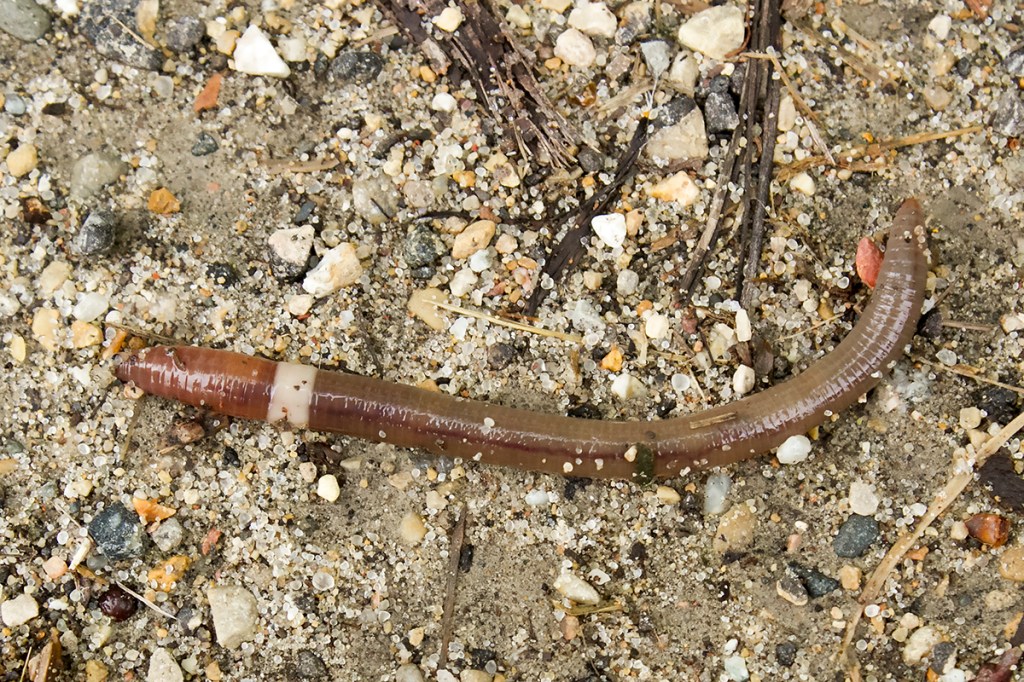Disturb a jumping worm and it’s like a nightcrawler on steroids: It violently writhes on the forest floor, recalling a snake in a bad horror movie. Try to catch it, a piece of its tail will detach in your hand — still wriggling as you hold it.
But put aside the creepy factor: jumping worms may be the next big threat to northern forests.
Jumping worms, consisting of various non-native species from multiple genera, have become established in a number of eastern and southeastern states. In 2013, species from the genus Amynthas were confirmed for the first time in the Upper Midwest, at the University of Wisconsin-Madison Arboretum.
In the forests and prairies of the Upper Midwest, the jumping worm could significantly alter habitats and decrease biodiversity. Why are they so damaging? And is there anything we can do to stop them?
Why Much of What You Know About Earthworms is Wrong
You probably learned about the wonders of earthworms at an early age. They aerate the soil. They help your garden grow. And they catch fish. The humble earthworm is a creature to celebrate.

Overlooked in all this earthworm love is an important fact: in a significant portion of the North American continent, no native earthworms have existed since before the Ice Age. As such, forests and other habitats have evolved without them.
But people love earthworms. They indeed use them by the millions for fishing, and for composting, and to help gardens grow. And so the worms have been spread far and wide. Even areas with native earthworms have largely been taken over by non-native varieties. The common nightcrawler — familiar to anyone who has ever cast a bobber and hook — is a European species.
Earthworms have also spread into the northern habitats where worms have been absent for thousands of years. The hype is true: earthworms cycle through a lot of refuse, and fundamentally change the soil. This may be good in your backyard garden plot, but it’s not in the northern forest.
“Earthworms change the environment to suit their needs,” says Brad Herrick, ecologist and research program program manager at the University of Wisconsin-Madison Arboretum. “When they are introduced, they make a host of physical, chemical and biological changes to the soil environment.”
Essentially, worms turn the forest floor — a complex community of plants, invertebrates and microbes – into a completely different habitat.
The jumping worm, if established in the Upper Midwest, brings new threats. “We think the changes to native habitats will be similar to other earthworms but even more dynamic,” says Herrick.
Spread of the Jumping Worm
You probably think of earthworms as living underground. But the jumping worm actually lives in the topmost layer of the forest floor — amongst the fallen leaves and other material that cover the soil. It eats that fallen organic material. And that’s the problem.
That leaf litter provides essential nutrients to the forest. Trees need long-lasting sources of nutrients. When jumping worms quickly turn leaves into very loose soil (resembling coffee grounds), they deprive trees of essential nutrients.
They thus can inhibit the establishment of tree seedlings. The altered soil is inhospitable to many native plant species. And that soil also disrupts the relationships between fungi and trees.
In short, the jumping worm could have profound effects on the overall forest ecosystem.
As with so many invasive species, they’re adaptable and difficult to stop. They’re parthenogenetic: they can reproduce without fertilization. The introduction of a single individual is enough to launch a jumping worm invasion.
The worms have an annual life cycle. They die in the fall, but leave tiny cocoons that spend the winter in the soil.
And they can be spread readily by human habits. Take their preferred habitat of fallen leaves. At this time of year, many people are raking leaves into a pile and setting them by the road to be picked up or converted into mulch. The worms — or their cocoons — are thus transported to new habitats. Compost and potted plants can also move the worms around.
“Unfortunately at this time, there are no good control measures,” says Herrick. “The important thing now is to the stop the spread. Everyone can help.”
Stop the Jumping Worm
Herrick and other conservationists agree that prevention is the most effective tactic. If you live in the Upper Midwest, and see a writhing, snake-like earthworm in your backyard, report it to your state natural resources department. (In Wisconsin, you can email invasive.species@wi.gov to report sightings).
The Wisconsin Department of Natural Resources also has a handy identification card to help you distinguish the jumping worm from the common nightcrawler.
Wisconsin DNR also suggests examining potted plants and gardening and landscaping materials for the presence of jumping worms. If you are doing landscaping and gardening work, be sure to clean your equipment and clothing to prevent transporting cocoons.
And if you buy compost, only buy from sources that heat the compost at appropriate temperatures and duration to kill pathogens.
The jumping worm is not yet established in much of the northern United States. The time is now to keep it from becoming the next invasive species horror story.




This article was extremely informative. I never knew that worms could be bad for the environment.
Hello Matt,
This is a new one for me, jumping worms. Thanks for the tip of heated compost. Could we send some to congress and Donald Trump Daily Show? Do you think they could survive his bluster?
This is a bad time for science and conservation in general with DT in charge. He doesn’t venture into the wilds. But I am glad you do and are walking in Aldo Leopold’s footsteps . I wish you well and hope you continue all you do in good health for all of us.
Darla Rae Duffy
Pittsburgh, Pa.
Thanks so much! I will share your film with the crew of volunteers that work at my church
Good reminders for all of us. There are 30,000 invasive species in the U.S.A. causing $148 billion in damages/year. Thank you for the excellent reminders.
Great article Matt,
Any news if these worms have made there way into Northern Virginia? If so, any way of combating it naturally?
In NJ, I’ve come across worms that act as “violently” as these but never saw them dislodge a piece of their body and don’t know they are indeed jumping worms. Have they been found in NJ?
Thanks Matt for the heads up. It appears prevention of disease in any life cycle is the first step.
yea so if I see it what do I do with it? report it I will for sure But how do I rid myself of it in the mean time?
Maybe we should allow burning of leaves again. Would that help destroy the worms?
Things have gotten so out of hand with so many non native species in various parts of the United States. It is hard to keep track of them all. Now there’s the threat of jumping worms.
Why is this a problem now. Where are they native to.They will most likely not survive due to the millions of gallons of Roundup sprayed on our plants and leaves.
I hope the invasive group will address the ongoing feral/roaming cat problem, if they haven’t already, and how Trap-Neuter-ReIMPOSE programs don’t work.
First, my thanks go to the author for the heads-up on the worms, another gift from Asia (here in western NY we’re in the hot zone of Emerald Ash Borer, another gift from that part of the world).
And yes, Maja, I would like to see free-roaming cats officially classified as “invasive” so proper control (i.e. removal) can be implemented. The fact that this hasn’t occurred is because it’s a political hot-potato. Don’t hold your breath.
I noticed many garden snacks in my garden during summer time , but i also noticed this gum- pin worm
in late October . Thanks for art. and info. this was unpleasant to see this ,I will give them sugar with baking soda on start.
We recently discovered these near our home in Northern California. They are clearly different from the typical worms we have seen here before, and can jump up to two inches if touched in attempts to move them.
Unfortunately, I met the jumping worm late this summer. I was turning over my “working” compost pile and discovered a large number of hyperactive worms writhing around. I live on the east side of Madison, WI. I’m not sure what the method of their introduction to my property was, but I have now found them in one of my raised beds. They have also spread to my other two finished compost piles. I tried black plastic bagging them in the sun for several weeks, but it did not kill them. And of course, there’s the cocoons still in the soil. I hope researchers come up with a remedy for these pests. These are not the worms we’re used to!